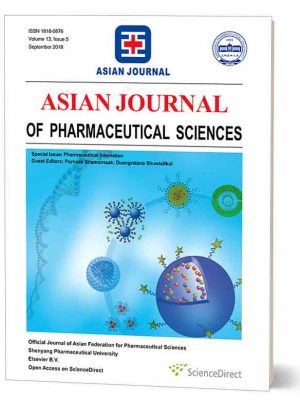
Design and characterization of monolaurin loaded electrospun shellac nanofibers with antimicrobial activity (2018)
Abstract
The aim of this study was to develop the water compatible form of coconut oil through nano-emulsification. The effect of different types and amounts of surfactants on the physical characteristics of nanoemulsions containing coconut oil was investigated. Coconut oil nanoemulsions containing varied amounts of surfactants including polyethylene glycol octyl phenyl ether (PGO), polyoxyethylene sorbitan monostearate (POS), polyethylene glycol hydrogenated castor oil (PHC), sodium lauryl sulfate (SLS) and poloxamer 407 (PLX) were formulated and comparatively evaluated for their physical properties. The results showed that the coconut oil nanoemulsions using PGO, POS and PHC as surfactants exhibited low percent creaming index indicating excellent stability, while those containing SLS and PLX demonstrated the higher percent creaming index suggesting lesser physical stability. The droplet sizes of nanoemulsions consisting of 5% (w/w) PGO, POS and PHC were 22.843, 4.458 and 0.162 µm, respectively. Thus, coconut oil nanoemulsions with the smallest size could be obtained when PHC was applied. Furthermore, the droplet size of nanoemulsions decreased from 33 µm to less than 200 nm with an increase in the amount of PHC from 1% to 10% (w/w). Additionally, the properties of coconut oil based nanoemulsions containing PHC were not changed through temperature cycling test. From these results, it was suggested that the fabrication of stable coconut oil nanoemulsions with small particle size could be easily achieved by using 5% (w/w) PHC as a surfactant. The knowledge gained from the study might provide the basic guideline for the fabrication of stable nanoemulsions for food, cosmetic and pharmaceutical fields in the future.
Link to Publication: https://www.sciencedirect.com/science/article/pii/S1818087617308267
Bibliography :Sirikarn Pengon, Nawinda Chinatangkul, Chutima Limmatvapirat, Sontaya Limmatvapirat. (2018). The effect of surfactant on the physical properties of coconut oil nanoemulsions. Asian Journal of Pharmaceutical Sciences, 409-414.

Determination of mono-, di-, and trilaurin in modified coconut oil using HPLC–ELSD (2016)
Abstract
Modified coconut oil (MCO) enriched with monolaurin (ML) was prepared by the glycerolysis of coconut oil [1]. Glycerolysis converts dilaurin (DL) and trilaurin (TL) into ML, the lauric acidmonoglyceride. ML has been found to have antiviral, antibacterial and antifungal activities[2]. According to the antimicrobial activity, the glyceride composition of MCO was determined. The concentrations of ML, DL, and TL in MCO were analyzed using high-performance liquid chromatography–evaporative light scattering detector (HPLC–ELSD).
The HPLC–ELSD analyses were performed using an HPLC 1200 series equipped with an ELSD and a ZORBAX Eclipse Plus C18 column (4.6 × 250 mm, 5 µm) from Agilent Technologies Inc. The mobile phase consisted of 0.01% (v/v) acetic acid in acetonitrile(solvent A) and acetone (solvent B) and was degassed by ultrasonic bath prior to use. The HPLC column temperature was 25 °C. The mobile phase was maintained at a flow rate of 1.0 ml/min with the following gradient condition: solvent A:solvent B (90:10 v/v) from 0 to 5 min to solvent A:solvent B (70:30 v/v) from 5 to 10 min to solvent A:solvent B (50:50 v/v) from 10 to 15 min to solvent A:solvent B (30:70 v/v) from 15 to 20 min to solvent A:solvent B (20:80 v/v), and then held for 10 min. The equilibration time between runs was 10 min and the injection volume used was 10 µl. The temperature of the nebulization was set at 40 °C and nitrogen gas was 3.5 bar.
The ELSD were capable of a linear response (R2 > 0.9995) independent of individual glyceride molecular structures at concentrations between ~0.02 and 0.40 mg/ml. Intra- and inter-day reproducibility (n = 5) were evaluated under the optimized conditions. The relative standard deviations for glycerides were less than 2.45%. The detection limits (LODs) and the quantification limits (LOQs) were lower than 0.054 and 0.162 mg/ml, respectively. The efficiency of this method, measured through the recoveries, was higher than 96.06%. The elution order of the standards was ML < DL < TL as shown in Fig. 1. The DL and TL standards eluted after the ML standard, indicating that the hydroxyl moiety on the glycerol backbone contributed significantly to retention. The concentrations of ML, DL, and TL of MCO derived from various conditions of glycerolysis were in the ranges of 102.70–247.25 mg/ml (ML), 52.65–79.87 mg/ml (DL), and 12.27–39.60 mg/ml (TL).
Keywords: Monolaurin, Dilaurin, Trilaurin, Modified coconut oil, HPLC–ELSD
Link to Publication: https://www.sciencedirect.com/science/article/pii/S1818087615001889
Bibliography : Juthaporn Ponphaiboon, Sirikarn Pengon, Amornrat Chaidedgumjorn, Sontaya Limmatvapirat and Chutima Limmatvapirat. (2016). Determination of mono-, di-, and trilaurin in modified coconut oil using HPLC–ELSD. Asian Journal of Pharmaceutical Sciences, 11(1), 223-224. (conference abstract).